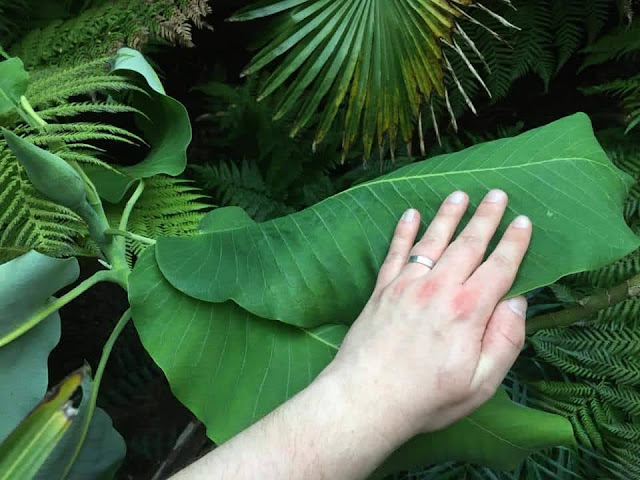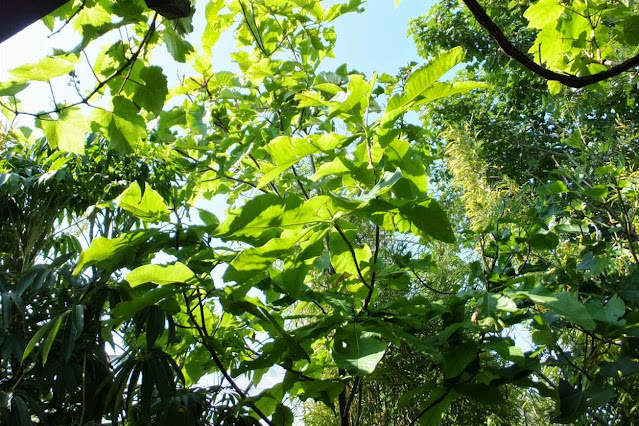As I look at the plants in our utility and greenhouse area, I found myself admiring three of the big leafed magnolias there waiting to be planted. I seem to have inadvertently collected them, finding myself gravitating towards them at nurseries, buying them, and figuring out where to plant them as an after thought of the purchase. These are big trees and our garden isn't exactly big enough to accommodate them all. But hey, there is fun in not being too sensible!
 |
| Magnolia macrophylla blossom |
Big leafed Magnolias are still underused for domestic back gardens in the UK to create a tropical and jungle style garden. With their big, tropical looking leaves they also have the bonus of good hardiness and providing structure and backbone to the garden.
I won't go much into detail about their cultural requirements but broadly mention that they do prefer a neutral to acidic soil and dappled shade to full sun (especially when they start to tower over everything else, not much choice when that happens). What I do find is that most of them seem to tolerate chalky conditions a lot more than usually perceived. Our garden has an acidic pH but over a foot down it sits on alkaline, chalky subsoil and most seem to do fine and thrive away. Perhaps they'll do even better if we had neutral to acidic soil all the way but I can only offer what we've got....
Here's a guide to hardy (always with caveat to this word), big leafed Magnolias for the domestic garden to help create a tropical/exotic/jungle style garden in the UK....
Magnolia macrophylla (American Bigleaf)
 |
| Magnolia macrophylla |
Also known as THE Bigleaf Magnolia, the grand dame or the queen of them all, with it's huge leaves measuring between 25-80cm long and 11-30cm wide, with reports of leaves sometimes reaching a metre long. It is such a showstopper of a plant and deserves a pride of place in a garden. Ours is several years on the ground already and around 15 feet in height. It's a good one too for underplanting once the tips are up and out of the way. We have another one waiting in the wings as seen on the photo below
 |
| Our waiting in the wings Magnolia macrophylla |
Magnolia macrophylla subsp. ashei (American Dwarf Bigleaf)
 |
| Throwback pic of our Magnolia macrophylla subsp. ashei |
A smaller version of the above that is also considered a species on it's own right by some botanists (Magnolia ashei). Despite it's more compact habit it still produces relatively big leaves, has an elegant form and holds it's own right as a thing of beauty. Due to it's smaller size, more suitable for smaller gardens. We used to have one thriving for many years in front of our jungle veranda but alas went terminally backward last year but it was a joy to have while it lasted. I'm sure I'm bound to get a replacement sometime very soon, too nice not to have again.
Magnolia delavayi (Chinese Evergreen Bigleaf)
 |
| Magnolia delavayi |
Fancy having a plant with that tropical, big leafed green ficus look to it and yet remains looking like that all year round, even in the depths of winter? Then this Evergreen Bigleaf Magnolia is for you. Can't sing this plant enough praises and would have been towering in our garden by now had if we didn't lose our original and well thriving plant in the garden fire of 2013. It has large, deep green and leathery looking leaves with the tree itself having a graceful habit.
Since then we have replaced it with another one on the exact same spot and is doing really well. It was already too dark to take a photo of it whilst writing this so instead the photo above is a much smaller, newly planted one in another part of the garden.
Magnolia dealbata (Mexican Bigleaf)
 |
| Magnolia dealbata |
A stunning big leafed Magnolia from Mexico whose leaves seems to be a bit more rigid and held with more structure and has very silvery undersides. I love the habit and form of this Magnolia and the fallen leaves in autumn retain their silvery colour so well that they almost glow in the dark as they reflect moonlight on a clear night. So not one for leaves to be tidied away quickly once they have been shed.
Some botanists also consider this as a subspecies of macrophylla so can also go by the name Magnolia macrophylla subsp. dealbata but much like Ashei holds it's own right. We have this planted among tree ferns and one of the few plants that doesn't seem to protest being surrounded by their matted roots. May need staking and training to encourage very upright growth but I'd say well worth the effort.
Magnolia rostrata (Himalayan Bigleaf)
 |
| Magnolia rostrata (photo by Dieter Albrecht) |
Also known as the Beaked Magnolia with its large leaves with distinctive coppery bronze tinge to the new growth that persists for awhile. If dealbata is silver, this would be bronze (just a personal term). And it's also the only one I don't have, on the basis that it's not that hardy and would require a sheltered spot. Do I really need another borderline plant to molly cuddle in the winter? Probably not but like that has ever deterred me. But every time I see those large, brownish leaves I am tempted, very tempted. Photo above borrowed from the internet.
Magnolia obovata (Japanese Bigleaf)
 |
| Our baby Magnolia obovata near centre of the photo |
Supposed to be one the easiest to grow big leafed Magnolias that has good tolerance for slightly alkaline soil. This has grown really well in our garden and attained height relatively quick too, already 15 feet tall planted out from a three feet plant four years later when alas, we also lost it to the garden fire of 2013. We haven't replaced it since but finally managed to get a new one last year as seen on the pic above.
Magnolia officinalis (China)
 |
| Magnolia officinalis |
Officially not classed as a 'bigleaf magnolia' as such, but it has big leaves and botanically differs very little from Magnolia obovata which is a 'bigleaf magnolia' (go figure). Some botanists believe this might actually be a subspecies of obovata altogether. A new one for us and waiting in the wings for placement so watch this space...
Magnolia tripetala (American Umbrella Tree)
 |
| Magnolia tripetala |
A bigleaf magnolia with, as the name suggests, large leaves that are clustered at the tip of the branches having an umbrella like character. A hardy tree that is supposed to be the easiest to grow and most tolerant of slightly alkaline conditions. We have found this true ourselves by our plant growing away nicely with very little extra attention and is now the tallest magnolia we have in the garden. A stalwart of a plant that we highly recommend!
 |
| An older photo of our Magnolia tripetala |
Mark :-)




 This gardening blog follows our journey as we create our Tropical and Exotic themed garden. We hope you'll enjoy the journey as much as we do. We started our Exotic Garden in 2005 and this site will show its development, as well as our travels, both abroad and within the UK to gardens, nurseries and friends.
This gardening blog follows our journey as we create our Tropical and Exotic themed garden. We hope you'll enjoy the journey as much as we do. We started our Exotic Garden in 2005 and this site will show its development, as well as our travels, both abroad and within the UK to gardens, nurseries and friends.













Wow, you do have a collection! I've got a single Magnolia grandiflora, which I inherited with the garden, but I've been tempted to pick up one of the shorter varieties just because they're so darn pretty. I've no idea where I could put it, though, and with water use now a serious problem here getting a new tree established is a dicey proposition under any circumstances.
ReplyDeleteThe collection was a bit accidental, kept gravitating towards them then lo and behold. They are beautiful trees even well after their short floral display. Hope you find a suitable one and water shortage in your area will have an appropriate solution soon (fingers crossed!).
DeleteNever thought of a Magnolia for a tropical look, but I guess it's all about the leaves. Interesting perspective on Magnolias, from the point of view of leaf size. Most focus on the flowers in my area--here basically only M. grandiflora is common, with the odd x soulangeana or Michelia scattered around. A good reminder that Magnolia is a big genus!
ReplyDeleteHuge genus indeed. Most of the time they do get credit for their floral display, albeit rather very shot most of the time. But the leaves on some of them, as well as their overall habit make them worthwhile additions to the garden.
Delete